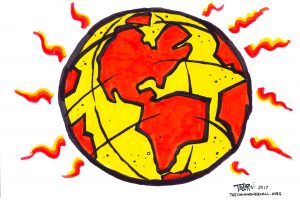
By
HuffPost (6/11/19)
There’s a reason why bananas are the world’s favorite fruit. They are cheap to buy, soft and easy to eat and full of fat-free nutrients. Frequently found in our lunchboxes, breakfast mix and often one of the first foods babies eat, they are a household staple. More than two-thirds of U.S shoppers include them in their regular grocery shopping.
But the much-loved banana is in trouble. Two damaging diseases are destroying our favorite yellow food and threatening to wipe out the bananas eaten by consumers in the U.S.
“Banana production as it stands is facing an existential crisis,” said Dan Bebber, a plant and disease specialist at the University of Exeter. “There will have to be a revolution in how bananas are produced for production to continue.”
Bananas have been eaten in the U.S. since the 19th century. But the rapid development of large-scale banana plantations and improved transport links from export markets in South America in the late 1800s facilitated a boom in consumption in the 20th century.
The fruit now generates revenues of more than $8 billion a year for banana exporters including Ecuador, the Philippines, Costa Rica, Colombia and Guatemala.
But the banana’s reign as a cheap and plentiful fruit could be coming to an end, through a combination of factors that tell a bigger story about the dangers of our food system.
Bebber has just published new research explaining the growing risk of a fungal disease that largely wipes out the banana crop of any tree that it infects.
The Black Sigatoka disease originated in Asia in the late 20th century, say researchers, but has now spread to the Caribbean and been found as far north as Florida. That spread, says Bebber, is being assisted by the impacts of the climate crisis as it unfolds in the key banana-growing regions of Asia, South America and the Caribbean. …
(Commoner Call art by Mark L. Taylor, 2017. Open source and free for non-derivative use with link to www.thecommonercall.org )
*****
Scientists Find The First Bee’s Nest Made Entirely Of Plastic
LAST SUMMER, SCIENTISTS IN SOUTH America were studying the impact agricultural practices have on the surrounding ecosystems, and specifically how natural areas and fields are pollinated as a result of their proximity to one another. In the midst of this analysis in San Juan, Argentina, the team of researchers made a totally unexpected discovery: a bee’s nest made completely from plastic.
San Juan is a region with a desert climate abutting the Andes that is nonetheless known for wine production, among other crops. Most growing operations there are family run, which provides a lot of data for those studying the relationships between human activity and nature. In this case, that means human-made materials finding their way into an unexpected place.
“The nest was found in a chicory field for seed production in San Juan, Argentina,” says Mariana Laura Allasino of the National Agricultural Technology Institute, who coauthored a report on the find in the journal Apidologie. The nest belonged to a bee from the family Megachilidae, which are solitary bees that often build nest cells from material they collect, such as soil, bits of leaves, and even animal fur. In this case, the nest cells were made of “light blue plastic, of shopping bag consistency,” and “white plastic, thicker than the previous one,” Allasino says.
“Due to our activities, human beings are contributing to the ecosystem’s degradation and biodiversity loss. …”
*****
Climate Crisis Could Spread Dengue Fever Through Most Of Southeast US
If greenhouse gas emissions continue to rise until 2080, dengue fever could spread through much of the southeastern U.S. by 2050.
That’s one of the findings in a study published in Nature Microbiology Monday on the potential spread of the mosquito-borne disease, which currently kills around 10,000 people per year and sickens 100 million. The study also predicted the disease would expand to higher altitudes in central Mexico, to northern Argentina, to inland Australia, to large coastal cities in eastern China and Japan, to southern Africa and to the West African Sahel.
The study incorporated data on mosquito behavior, urbanization and different climate change scenarios to predict how dengue fever would spread in 2020, 2050 and 2080, The New York Times explained. In the most extreme climate scenario, emissions continue to rise. In another, emissions rise through 2080 and stabilize by 2100 and, in the third, they peak in 2040. In all scenarios the spread of dengue increased, but it decreased slightly between 2050 and 2080 in the lowest-emission scenario. …

